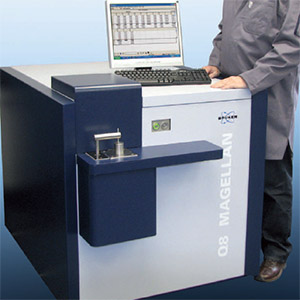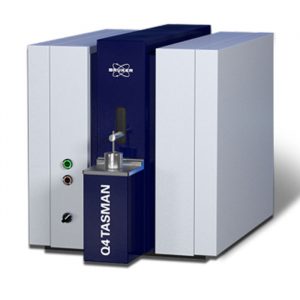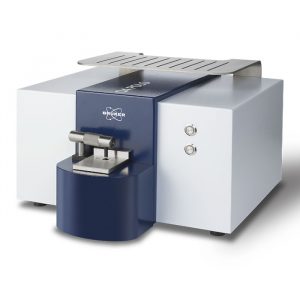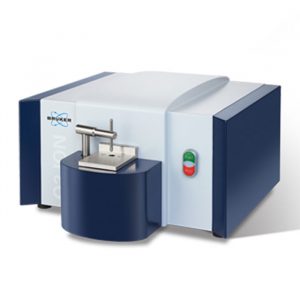Q8 MAGELLAN is the perfect symbiosis of approved and new – tradition and innovation
The Bruker Q8 Magellan is the pinnacle of Optical Emission technology. It is the first spectrometer worldwide that offers a previously unseen quality of analysis because of its unlimited combination possibilities of measurement parameters. Unique in design brings a world first for a vacuum spectrometer that features photomultipliers, digital plasma generator, unlimited single-spark- and time resolution and a heavy duty, low-maintenance spark stand with co-axial argon flow.
Overall, this system is an absolute masterpiece and is perfect for those with challenging, unique or for those looking for very low levels of PPM/%
Optical system
• Paschen Runge / 750 mm
• Wavelength range: 110 nm – 800 nm
• Photomultiplier detectors: Highest anode sensitivity; Very stable and low dark current
• Up to 128 analytical channels
• Single vacuum optic
Read-out system
• Time-resolved reading of single sparks; Individually settable integration windows for all analytical channels with simultaneous acquisition of each single spark
• Scalable and microprocessor controlled read-out system; Use of modern and programmable electronics for time-critical jobs; Integrators are matched to detector characteristics; High-quality PCI data recording board with a sampling rate up to 250 kHz
Instrument control
• Communication: Use of Ethernet and TCP/IP between PC and instrument as well as for all instrument internal communication
Source
• Digital generation of any discharge current curve through programmable logic modules
• Integrated emergency stop
• Maintenance-free, inductive ignition
• Discharge time 10 µs to 2 ms
• Max. 200 A peak current
• Max. 1000 Hz spark sequence
Software
• Analysis software with integrated single spark evaluation
• Material quality monitoring with dynamic internal and external limit check
• Material identification of unknown samples
• Analysis management: Integrated analysis management using SQL data base; Storage, sorting, filtering, display, searching, printing, archival; Comprehensive statistic evaluation, SPC charts (option), certificate
• Email supported reporting system
• Integrated systems for diagnosis and maintenance via internet or telephone provide efficient service at short term
Element analysis of:
• Iron & steel alloys and traces
• Nitrogen in steel
• Aluminum alloys and traces
• Copper alloys and traces
• Oxygen in Copper
• Nickel alloys and traces
• Cobalt alloys and traces
• Magnesium alloys and traces
• Tin alloys and traces
• Lead alloys and traces
• Titanium alloys and traces
Cleanliness determination and Inclusion Analysis in Steels with Q8 MAGELLAN & MCI
The present production of steels shows demanding requirements for quality, especially the needs for homogeneity and cleanliness are increasing. The key to premium steel products is best cleanliness degrees and lowest levels of Oxygen. The classic way to determine non-metallic inclusions is usually using metallographic microscope and scanning electron microscope with EDX analysis (SEM-EDX). These methods are slow and cost-intensive applications. Using optical emission spectroscopy with pulse discrimination analysis (OES-PDA) means fast and efficient determination of the cleanliness degree and oxygen level. During the melting process these quality indicators are available and allow the process control in real-time.
In addition, a fast quality check of the final product is one of the main advantages of this method. For this purpose, Bruker Elemental has developed the software package MCI, “Metal- Cleanliness-Inspection” for the spark spectrometer Q8 MAGELLAN. The MCI-Software evaluates on a statistical basis the sparks, which are caused by non-metallic inclusions. The main features are the determination of:
• Total oxygen content
• Oxide and sulphide inclusions
• Grain size distribution of different oxide and sulphide types (e.g. alumina, Ca-aluminate, Mg-spinel)
Purity evaluation of materials at the incoming inspection with Q8 MAGELLAN & MCI
Using the Q8 MAGELLAN – Bruker Elemental’s optical emission spectrometer, in conjunction with our MCI software package – to determine the purity of materials at incoming inspection enables accurate assessment and classification of suppliers and their delivery quality, leading to optimized margins. For critical products, such as those in the aerospace or wind energy business, the selection of the right materials and material grades is of utmost importance. Defective materials associated with critical components that fail can cause entire plant production lines to halt. Selecting the proper materials and ensuring their delivery is crucial. To reduce these critical failures, high quality materials with excellent purity levels are required, and a company’s ability to reject substandard materials is essential for success.
Quality and safety are maximized with proper materials. However, this is in contrast to the economic analysis where the margin is always in the foreground. Striking a balance between optimal quality and margin is necessary in every industry: use as much as necessary – but use as little as possible. Especially in a world where globalized goods traffic is the norm, the assessment of suppliers and their delivery quality is difficult, but making an accurate analysis of supply sources and grades of material is required. Knowing which supplier consistently provides a particular grade of material demonstrates a supplier’s reliability and a classification is possible: material suppliers can be ranked A, B or C, and purchasing costs are reduced. A sampling of materials during incoming inspection will give approximate values, but in order to achieve a robust classification with regard to delivered quality and purity, it is necessary to perform a comprehensive examination of the material. Ideally, a complete examination of the materials should be performed when the material is received.
Using a detailed analysis and the knowledge of who can provide that quality at what price, the optimization of margins is ultimately possible. Previously, the method for evaluating the degree of purity was by using a microscope or scanning electron microscope (SEM -EDX ). This method required a significant effort, was costly, and was time consuming, allowing for only partial sample reviews. But now, Bruker Elemental offers a tool to expedite the process. The Q8 MAGELLAN can give information about the purity level and the oxygen content of a material, in addition to determining its chemical composition. The review of the optical spark emission spectrometry can be done along with the usual element analysis. The time required is negligible (a few seconds), sample preparation is very simple, and the evaluation can be performed on the same equipment.
All systems are supported by Trained Engineers who cover the whole over the UK.
• Help desk support from highly-skilled troubleshooting professionals, to isolate and resolve hard- and software problems
• Web-based remote instrument service for service diagnosis and applications support
• Merged reality support with Help Lightning – a virtual engineer at your side (video)
• Planned maintenance, according to your requirement
• Customer on-site repair and maintenance service
• Spare parts availability typically over night or within a few working days worldwide
• Compliance services for installation qualification, operational qualification / performance verification
• Site planning and relocation




